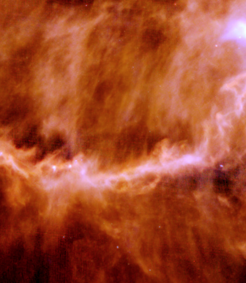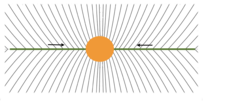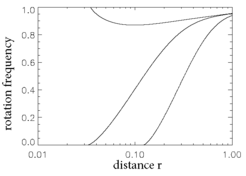The formation of (very) slowly rotating stars
Some stars are observed to rotate with extremely long periods, the ‘slow rotation problem’. A theory developed at MPA now shows how the magnetic field of a star’s ‘birth cloud’ can cause some stars to accumulate mass without acquiring significant rotation.

The famous star forming filament B211 in the Taurus molecular cloud, as observed with the Herschel satellite. Above and below the filament threads called 'striations' are faintly visible, they trace out the magnetic field of the cloud. Radio telescopes show that gas flows towards the filament along these striations, guided by the magnetic field. In the dense gas accumulating in the filament itself stars are forming, a few are already visible as bright dots.
Some stars rotate much faster than the Sun. The star CU Virginis, a single star in the constellation Virgo for example, has a rotation period of only half a day. At the other extreme are stars like Gamma Equulei (the nose of the little horse), which rotates with a period of at least 70 years. That's more than 50 000 times slower. Both stars are members of a special class, the so-called ’magnetic Ap stars’. (Both are just visible with the naked eye.) The rotation period of Ap stars can be measured from changes of the observed strength of the magnetic field on its surface, as the field configuration rotates into and out of view.
But also ‘normal’ stars more like the Sun show something related: already at a very young age they rotate with periods ranging all the way from a half a day to some 100 days. The rapidly rotating ones are easily explained: small random motions in a star forming cloud are amplified by ‘angular momentum conservation’, in parts of the cloud that contract to form protostars. If this were the only effect, however, it would produce only very rapidly rotating stars.

Schematic showing the expected shape of the magnetic field lines around a protostar in objects like the B211 filament of Fig. 1. The field lines, still connected at large distances to the star forming cloud, have a kink at the midplane. This distortion is due to the weight of the gas (green) under the force of gravity of the protostar (yellow). The kinks are subject to diffusion of gas across the field lines, allowing the gas to accrete onto the protostar (arrows).
But the contracting gas also has a magnetic field, which gets amplified by the same contraction. At some stage(s) of the star formation process (in particular inside the Herschel filament of Fig.1), this field will be ‘bent’ (see the sketch in Fig. 2). This magnetically dominated form of accretion is sometimes called a pseudodisk, as it differs from the standard view of stars building up their mass through an accretion disk without a strong magnetic field. This view assumes that the magnetic field has largely left the gas already at an early stage. In such a disk the host star’s gravitational attraction is balanced by orbital rotation of the gas (like planets orbiting their host star).
In a pseudodisk, however, the magnetic tension force between the contracting core and the birth cloud to which it is still connected tries to maintain the very slow rotation of the cloud. The balance between angular momentum conservation and magnetic tension now determines whether the star formed will be a slowly or a rapidly rotating one. Observations appear to show that the balance can tip either way. The work reported here explains how this balance works, and how it can lead even to extremely long rotation periods.

Orbital frequency of the gas drifting towards the protostar, in units of the frequency of a local Kepler orbit, as a function of distance r from its centre. Starting at the right boundary (r=1), with a frequency just below that of a Kepler orbit, the calculations show how the rotation of the gas changes as it approaches the protostar (at r=0). With only small differences in the initial rotation, there are two possible outcomes: either the tendency to conserve angular momentum wins and the gas ends up on a Kepler orbit (upper curve), or magnetic torques win and the gas loses its rotation (lower two curves).
Minor differences in the random velocities in the initial state of the star forming gas cloud can lead to opposite outcomes: either very fast or very slowly rotating stars (see Fig. 3). The very slowly rotating ones have accreted mass without accreting angular momentum. Key to the explanation of this result is the observation that it does not take much of a magnetic connection to extract the angular momentum of already slowly rotating gas. The slower the gas rotates, the more effective is the connection to the birth cloud in slowing it to even longer periods. Once this sequence of events is on its way, the gas will end up rotating on typical time scales just like the birth cloud, well before it ends up on the protostar. Its remaining path to the protostar is then determined by gravitational attraction, the opposing magnetic tension, and diffusion of gas across the field lines. A magnetic connection extending to a distance like the orbit of Pluto, for example, would be sufficient to explain final rotation periods of centuries. The calculations show that this unexpected outcome depends critically on the initial rotation of the gas: it has to be a bit slower than a Kepler orbit.
Observations of protostars indicate that they probably form episodically, in bursts rather than as a continuous process. This may also explain the range of intermediate rotation periods observed in young star clusters, if the balance tips randomly a few times between bursts of accretion with opposite outcomes. This speculation can probably be tested with the large new data sets becoming available from observatories like the Kepler satellite or ALMA.














